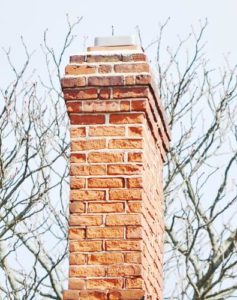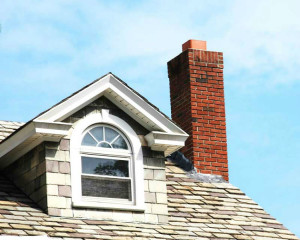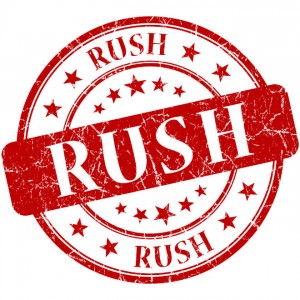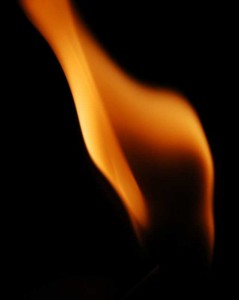For homeowners who own a fireplace system, deciding when to have it swept can sometimes be a mystery. Most of us know our chimneys need regular maintenance. The guesswork often determines when and how often we have our chimneys swept.
Most chimney sweeps recommend having your chimney swept at least once per year. However, there may be other reasons to call the chimney sweep. Below are some signs that your chimney needs sweeping!
Heavy use.
Do you use your fireplace as a primary heating source for your home? If so, it may need to be swept several times during the burning season. According to the Chimney Safety Institute of America, chimneys should be swept any time there is 1/8th of an inch of buildup in the flue. In normal burning conditions, this amount of buildup occurs after a full cord of wood is burned. Do you burn more than a cord of wood each burning season? Consider having a mid-season chimney sweeping done.
Before burning season.
After several months of sitting idle, your chimney may need to be cleaned before using the fireplace again. Sweep the chimney in the late summer or early fall before the burning season begins! This ensures that there are no debris or blockages in the flue. Also, it is especially important in areas where migratory birds are present or other animal entry into the chimney may have occurred.
New home.
Have you recently purchased a home? If you have, you may want to have the chimney swept before using the fireplace. Most home inspections include a cursory inspection of the fireplace system. Consequently, many inspectors may lack the knowledge to truly diagnose chimney problems. In addition, they typically will not clean the chimney. Having the chimney swept allows you to assess the condition of the fireplace system before you use it.
Performance problems.
Leaks, drafts, and odors – oh my! Is your chimney experiencing burning or performance problems? If so, a chimney sweeping and inspection may be necessary to discover the root cause of the problem. According to the National Fire Protection Association, “Chimneys, fireplaces, and vents shall be inspected at least once a year for soundness, freedom from deposits, and correct clearances. Cleaning, maintenance, and repairs shall be done if necessary.”
Annual maintenance.
Unless you are experiencing any of the reasons above, an annual chimney sweep is recommended for all homes. Having annual maintenance allows your chimney sweep to keep your chimney free from buildup or debris. Plus, it allows them to regularly assess the condition of your chimney. This allows the sweep to identify and address any areas of new or worsening deterioration. Also, as well as recommended any changes or improvements that need to be made to your fireplace or chimney system.
Regular chimney sweepings can keep you and your family safe an extend the life of your fireplace system. So, let your family continue to enjoy your fireplace for years to come. If you need to schedule your next chimney sweeping, contact Jack Pixley Sweeps today!
At Jack Pixley Sweeps , we pride ourselves on not just providing our customers with excellent fireplace and chimney services, but also helping to educate homeowners about their heating appliances. However, many of our customers often have the same questions!
Below are some of the most common chimney questions we are asked, as well as their answers and solutions.
“How often do I really need to have my chimney swept?”
According to the National Fire Protection Association , fireplaces and chimneys should be cleaned and inspected annually. This recommendation is a general guideline for most homes and fireplaces that is designed to keep your fireplace system in safe working condition. However, if you use a heating appliance such as a wood burning stove as your home’s primary heat source, your chimney may need to be swept more than once per year!
“What is creosote?”
Creosote is a tarry black substance that is a naturally occurring byproduct of fuel burning fires – as well as the root cause of many chimney problems. Excessive creosote buildup is the primary cause of chimney fire. Likewise, creosote can also create chimney odors or cause the flue liner to deteriorate.
“How does a chimney sweep clean a chimney?”
Chimney sweeps certified by the Chimney Safety Institute of America are highly trained professionals who follow specific guidelines and procedures designed to leave you with a clean – and safe – fireplace system. Using specialized tools including brushes and vacuums, the chimney system is cleaned and inspected from the top of the flue to the bottom of the firebox. Likewise, our chimney sweeps take care to ensure that your home does not get messy or dirty during the cleaning by using tarps and drop cloths to cover interior furnishings and floors.
“Do I need to worry about carbon monoxide?”
Carbon monoxide is created in all fuel burning fires, including gas, wood, kerosene, propane, and even charcoal. This colorless, odorless gas is sometimes referred to as the “silent killer” because it is nearly impossible to identify without special carbon monoxide detectors. While the risk of a well maintained fireplace system having a carbon monoxide leak is relatively low, it is important that all homes are equipped with carbon monoxide detectors and that the alarms are tested regularly.
“Can anything be done about my smelly chimney?”
Chimney odor can be a major nuisance, affecting the air quality in your home particularly in the spring and summer months. However, a smelly chimney is often an indicator of a bigger chimney problem. A chimney inspection can be used to identify the root cause of the chimney odor, repair it, and create a plan to prevent it from coming back.
“How long have you been in business?”
Jack Pixley Sweeps has been in business since 1977. Located in Spring Lake Park, Minnesota, we are a local company dedicated to providing our friends and neighbors quality chimney and fireplace services. For more information on what we can do for your chimney, contact us today!
After a winter of heavy use, most homeowners let their fireplaces fade into the background during the warm months of summer. For many, removing the remaining ashes, cleaning any stains, and wiping away soot leaves the fireplace ready for another season of use. However, fireplaces and chimneys should be swept by a professional annually to prevent any potentially hazardous buildup from becoming a far more dangerous issue down the road.
How often should my chimney be cleaned?
The CSIA, or Chimney Safety Institute of America, advises that chimneys be swept any time there is a sooty buildup in excess of 1/8th of an inch inside a flue or fireplace. As determining the amount of buildup can be difficult for the average homeowner, the CSIA recommends that they should “be inspected at least once a year for soundness, freedom from deposits, and correct clearances” by a certified chimney professional.
What time of year is recommended for a cleaning?

If it involves a chimney or fireplace, you can count on Jack Pixley Sweeps to know how to install it, repair it, clean it, and/or bring it up to code and national safety standards.
Although many homeowners wait until the weather cools off to schedule a chimney sweep appointment, it is important to have your system inspected before it is used for the first time each fall. Scheduling an appointment during the warm summer months not only guarantees that a system is in working condition when the weather begins to cool off, but also ensures that homeowners beat the fall rush and can schedule an appointment at their convenience.
Why are chimney inspections important?
Having a professional inspect and clean your chimney each year is an essential aspect of home maintenance. Unlike an average homeowner – or even a handyman – chimney sweeps are professionally trained to look for imperfections, flaws, and/or cracks that may not be visible to the untrained eye. While all systems should be inspected annually, inspections are especially important in homes that have recently had any upgrades or changes to their fireplace systems, such as converting to gas logs or the addition of a fireplace insert.
If you have recently purchased a new home, it is recommended that you have a cleaning done in the summer or fall, despite the timeline given by the previous homeowners, as this allows you to establish a relationship with a chimney sweep company, as well as informs you of the exact condition of your fireplace, flue, and chimney components. In some cases, it may be possible to work with the same company as the previous homeowners.
Scheduling an annual appointment with the same provider allows someone to become acquainted with the condition of your particular system who can then check on it over time to monitor its progress. This familiarity ensures that any changes such as cracks or blockages are quickly detected and mended, preventing the need for emergency maintenance or costly major repairs. Likewise, staying with the same provider over a period of time often means you do not have to schedule an appointment each year; traditionally, companies send out reminders to their repeat customers to let them know that they are due for an annual inspection.
Choosing the right company to handle all of your chimney and fireplace needs can be a tough task. Knowing which questions to ask can and will certainly smooth out the process for you.

Being an informed homeowner will make the process of selecting a chimney sweep a much simpler one.
Understanding the Anatomy of Your Chimney
Many people have fireplaces and chimneys in their homes and trust that they will always work as they are supposed to. However, there are many ways that a chimney could malfunction and it is important to understand exactly how this occurs. In order to maintain a safe chimney, homeowners should be familiar with the parts of their chimney and how they function. This will help them to quickly identify any issues that may arise and help you communicate with a certified professional.
At the very top of the chimney, there is a piece called a spark arrestor. This will keep sparks from leaving the chimney. A small spark may not seem like a big deal but, with the proper wind, a hot spark can quickly turn into a big fire. If this occurs on the roof, the fire will spread not only throughout the home, but it could also quickly jump to the neighbor’s home. Even very warm ash leaving the chimney can start a fire in this way, making the spark arrestor a vital piece of chimney safety.

It only takes a spark.
Also at the top of the chimney is a cement piece known as the chimney crown. This protects the upper layer of bricks on the chimney. More importantly, it helps keep foreign material out of the chimney. In addition to many other substances, it keeps excess moisture from entering the chimney, which can cause a great deal of structural damage. In addition to the chimney crown, many people also choose to use a separate chimney cap.
The long part of the chimney, which allows smoke out of the fireplace, is known as the flue. Inside of the flue is a long piece called the flue liner. This liner helps protect the flue from general wear and tear as well as damage from water. Liners come in a variety of materials, including clay, tile, and stainless steel. However, stainless steel is typically considered the best choice because it is the most durable and lasts the longest.
Inside of the chimney is a piece called the damper. The damper opens and closes the flue, either letting smoke out or trapping it in. It is very important to make sure that the damper is always open when burning a fire in the fireplace. Leaving it closed will quickly fill the entire home with smoke and dangerous gas.
Also inside of the chimney is a smoke shelf. This is a small piece that catches material falling through the chimney. This could be anything from ash to debris from animal nests inside of the chimney. If these materials find their way into the fireplace, they could start a dangerous blaze that quickly gets out of control. It is very important to make sure that the flue is always clear of all debris, but the smoke shelf provides extra protection in the event that anything does make its way in there.
When material burns in the fireplace, it creates combustible gas. The smoke chamber compresses the gas so that it does not create a back draft. Without it, the gas may enter the fireplace or the home, causing both health and safety risks for the entire household.
There are many different parts to a chimney and each plays and important role in the safe use of the fireplace. In order to use the chimney and fireplace without incident, homeowners should understand exactly how each piece works and what it does. This will make it possible for them to quickly identify any problems and decide what action needs to be taken before using the chimney again.





